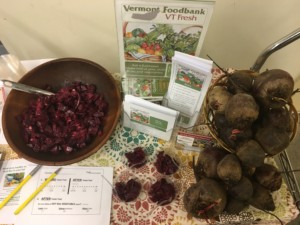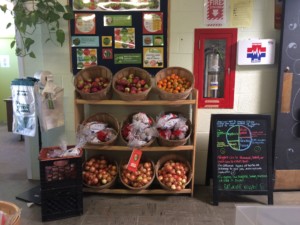By Emilie Riddle, Vermont Foodbank Intern from UVM
The food environment most of us experience daily in the United States is saturated with advertising for processed foods and provides easy access to cheap fast food and snacks. Fruits and vegetables are often the hardest things to add to our eating habits. Enter the Vermont Foodbank’s Veggie Van Go and VT Fresh programs. These programs are changing the public food environments at schools, hospitals and food shelves by offering fresh fruits and vegetables to taste and take home. The programs work by increasing access to healthy foods for members of the community. But they also help change the food environment by normalizing these foods as easy choices, and by creating a community space for conversation about cooking, nutrition and health.
By providing repeated opportunities to take produce and try samples the programs are building momentum. The Veggie Van Go event I attended last week saw the largest number of participants ever at the Barre City School—135 people! One of the participants, a student at the school, came back several times to rave about the sweet potato fries we were sampling, and to ask for a few more. He asked how long it would take to make them himself, and was ecstatic to take a copy of the recipe home with his bag of sweet potatoes. He even tried to get his cousin to try the sample, by demonstrating his own great enjoyment. His cousin could not be persuaded that day, but perhaps a seed has been planted for later!
The impacts of VT Fresh and Veggie Van Go also ripple out, and help people make changes in their home food environments. For those who already enjoy fresh fruits and vegetables, these events provide access and a supportive community to share ideas with. For others these events can be a catalyst for change at home. At a VT Fresh tasting at NEKCA in St. Johnsbury, a mom shared that her son loves the Veggie Van Go events at his school, and is always excited to bring home vegetables to use for dinner. She said that he brought home carrots and potatoes recently, and wanted to make stew with the lettuce they had at home (she suggested to him that cabbage might work better!). Another community member I met at NEKCA told us: “I would never have thought to make these
 Some of the impacts of VT Fresh and Veggie Van Go can be measured. Program evaluations show that taste tests increase willingness to try a new vegetable again, and there has been a 200% increase in produce distributed by partner food shelves. Other impacts can’t be easily observed. The stories I heard from participants suggest that seeds of change are being planted by VT Fresh and Veggie Van Go. Improving food environments and behaviors takes a long time, and these seeds will help us grow a healthier, more sustainable food environment in our communities.
Some of the impacts of VT Fresh and Veggie Van Go can be measured. Program evaluations show that taste tests increase willingness to try a new vegetable again, and there has been a 200% increase in produce distributed by partner food shelves. Other impacts can’t be easily observed. The stories I heard from participants suggest that seeds of change are being planted by VT Fresh and Veggie Van Go. Improving food environments and behaviors takes a long time, and these seeds will help us grow a healthier, more sustainable food environment in our communities.
Learn more about VT Fresh and VeggieVanGo!
